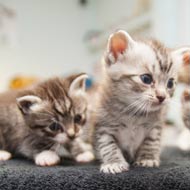Genome sequencing reveals cause of rare feline diseases

Dr Lyons and her team genetically sequenced the DNA of more than 50 cats.
US scientists have used genome sequencing to reveal the DNA abnormalities that cause genetic disease in cats.
Working with 99 Lives - a cat genome sequencing initiative - researchers from the University of Missouri identified the genetic variants that cause blindness in the African black-footed cat and Niemann-Pick disease in domestic shorthairs.
They hope that the findings, published in Scientific Reports and The Journal of Veterinary Internal Medicine, will inform breeding strategies for rare and endangered species in captivity.
“Genetics of the patient is a critical aspect of an individual’s health care for some diseases,” explained Leslie Lyons, a professor of comparative medicine at the University of Missouri. “Continued collaboration with geneticists and veterinarians could lead to the rapid discovery of undiagnosed genetic conditions in cats.”
In the study, Dr Lyons and her team genetically sequenced the DNA of more than 50 cats, both with and without known genetic health problems. The aim was to identify DNA that leads to genetic disorders and gain a better understanding of how to treat disease.
The researchers first sought to identify the genetic mutation that leads to blindness in the African black-footed cat - an endangered species found in US zoos. To identify whether the mutation was inherited or spontaneous, the researchers sequenced three cats - two of unaffected parents and an affected offspring.
The genetic mutation they identified was the IQCB1 gene, which is associated with progressive retinal atrophy. The affected cat has two copies of the mutation, suggesting that it is an inherited disorder.
The team then sought to identify a lysosomal disorder in a silver tabby kitten that had been referred to the university’s Veterinary Health Centre. They found that the kitten harboured two copies of the NPC1 gene, which causes Niemann-Pick type 1- a fatal neurological disease.
Researchers say that the discovery of both genes will help diagnose other cats and enable them to receive appropriate treatment. Using the black-footed cat study results, US zookeepers will be implementing species survival plans to help manage the cats in captivity.



 The RCVS has announced a new version of its 1CPD mobile app, with enhanced features for veterinary surgeons and veterinary nurses to record their continuing professional development.
The RCVS has announced a new version of its 1CPD mobile app, with enhanced features for veterinary surgeons and veterinary nurses to record their continuing professional development.